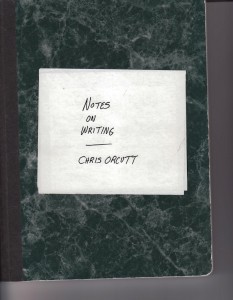My Writing Secret Weapon
For as long as I’ve been writing—over 20 years professionally now—I’ve collected articles on writing, handwritten snatches from books on writing, examples from great authors, as well as my own tips, tricks and hard-won wisdom on the art, and I’ve kept it all in a series of composition notebooks titled “Notes on Writing.”
 These notebooks are my Cliffs Notes of every (good) book or article I’ve read about writing, and they’ve proved invaluable over the years. Before starting a new project, rather than reread all of those books and articles, I simply reread the notebooks, giving myself a refresher course on story craft, characterization, punctuation, inspiration, grammar and much more.
These notebooks are my Cliffs Notes of every (good) book or article I’ve read about writing, and they’ve proved invaluable over the years. Before starting a new project, rather than reread all of those books and articles, I simply reread the notebooks, giving myself a refresher course on story craft, characterization, punctuation, inspiration, grammar and much more.
These notebooks are my secret weapon as a writer.
They are partly responsible for the excellent reviews my Dakota Stevens Mystery Series has been garnering—reviews like, “This book is magic” and “Another one out of the park” and “Real life took a backseat during the two days I was reading each of these books.” (Shameless plug: Book #1, A Real Piece of Work, is available here, and Book #2, The Rich Are Different, here.)
I reread my “Notes on Writing” before I start any major project, and I’m continuously adding to these notebooks from new books and articles. I also steal liberally from my writer and artist friends, jotting down their own wisdom without their knowledge, reminding myself that Picasso said, “Good artists borrow, but great artists steal.”
It’s a lot of work, and you have to be diligent about tedious things like copying quotes and getting the titles and by-lines right, but in the end it’s worth it: you have your own go-to writing resource. You never have to ask yourself, “Where did I read that excellent passage on characterization?” You never have to ask yourself that because, if it’s excellent, it will be in your notebook(s).
To help you get started with a notebook of your own (if you don’t already have one), I’m going to share a few entries from mine. Following are only a fraction of the quotes and ideas I’ve collected (I’m not giving you all of my best secrets), but these examples should be enough to inspire you to start collecting your own, and I strongly recommend that you do.
Betsy Lerner, editor & agent:
“If you are struggling with what you should be writing, look at your scraps. Encoded there are the times and subjects that you should be grappling with as a writer.”
Kurt Vonnegut:
“Make your characters want something right away—even if it’s only a glass of water. Characters paralyzed by the meaninglessness of modern life still have to drink water from time to time.”
Stephen Koch, Modern Library Writer’s Workshop:
“Use the badness of your first draft. Let the holes and dull spots tell you what needs to be filled and what needs to be cut.”
Ray Bradbury:
“What can we writers learn from lizards, lift from birds? In quickness is truth. The faster you blurt, the more swiftly you write, the more honest you are.”
Seneca:
“Ars longa, vita brevis.”
Truman Capote:
“The test of whether or not a writer has divined the natural shape of his story is this: After reading it, can you imagine it differently, or does it silence your imagination and seem to you absolute and final? As an orange is final. As an orange is something nature has made just right.”
John Braine on dialogue:
“If you can’t speak it out loud, it’s no good.”
Ethan Canin:
“Nothing is so important as a likable narrator. Nothing holds a story together better.”
Rudyard Kipling:
“…a tale from which pieces have been raked out is like a fire that has been poked. One does not know the operation has been performed, but everyone feels the effect.”
George V. Higgins:
“Nobody ever got started on a career as a writer by exercising good judgment, and no one ever will, either, so the sooner you break the habit of relying on yours, the faster you will advance.”
John Gardner in The Art of Fiction:
“Scenes are the ‘logic’ of a fictional argument.”
Chris Orcutt:
“Prefer predicate adjectival construction over nominative adjectival construction—produces a clearer set of images. Also, learn about syntactic slots (S-V-O) and the importance of not trying to pack all three slots with information. Packing slots clutters the sentence.”
and…
“The only shortcut in writing is the knowledge that there are no shortcuts.”
From Techniques of the Selling Writer:
“After a motivating stimulus to a character, the character’s reactions should come in the following order: feeling, action, speech.”
From Immediate Fiction:
“1 + 1 = 1/2.”
I’ll leave you to puzzle over the meaning of that last one until you read Immediate Fiction yourself and discover what he meant by that cryptic formula.
I hope you’re inspired now to run out, buy a composition notebook and start taking notes yourself. Over the years, this process of reading, copying down insights, and referring to them later has improved and deepened my writing. It’s one of my secret weapons, and now I offer it to you. Good luck.
Pingback: One writer’s secret weapon | onewildword